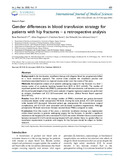Citation link:
http://dx.doi.org/10.25819/ubsi/9923Files in This Item:
| File | Description | Size | Format | |
|---|---|---|---|---|
| Gender_differences_in_blood_transfusion_strategy.pdf | 522.33 kB | Adobe PDF |  View/Open |
| Dokument Type: | Article | metadata.dc.title: | Gender differences in blood transfusion strategy for patients with hip fractures - a retrospective analysis | Authors: | Soost, Christian Daginnus, Alina Burchard, Rene Schmitt, Jan Graw, Jan |
Institute: | Fakultät III - Wirtschaftswissenschaften, Wirtschaftsinformatik und Wirtschaftsrecht | Free keywords: | Hip fracture, Blood transfusion, Transfusion practice, Intensive care unit length of stay | Dewey Decimal Classification: | 610 Medizin, Gesundheit | GHBS-Clases: | VXR VYR |
Issue Date: | 2019 | Publish Date: | 2021 | Source: | International Journal of Medical Sciences ; 17 (5), S. 620-625. - https://doi.org/10.7150/ijms.33954 | Abstract: | Background: In the last decades, transfusion therapy with allogenic blood has progressively shifted to a more restrictive approach. The current study analyzed the transfusion practice and transfusion-associated factors in a regional trauma center over the course of five years. Methods: Retrospective analysis of all patients undergoing surgery for hip fractures in a level 1 trauma center of an academic teaching hospital from 2010 to 2014 (n=650). The number of transfused packed red blood cells (PRBCs), preoperative Hb concentrations, and intensive care unit (ICU) and hospital length of stay (LOS) were analyzed. A logistic regression analysis was performed to evaluate transfusion and ICU LOS-associated risk factors. (Ethical Review Board approval: 2015-497-f-S). Results: From 2010 to 2014 the average number of PRBCs transfused per patient decreased continuously despite similar preoperative Hb levels. During the same period, ICU LOS increased while hospital LOS decreased. Advanced patient age, preoperative Hb concentrations, surgical complications, and ICU LOS were associated with increased transfusion requirements. Although preoperative Hb levels were lower, females received fewer PRBCs compared to males. Conclusion: Over the course of five years, a restrictive transfusion strategy was implemented within clinical practice in patients undergoing surgery for hip fractures. In parallel, a significant reduction in the hospital LOS and an increased ICU LOS was noted. Whether there is an association between increased ICU LOS and decreasing hospital LOS and whether there is a gender effect on transfusion requirements in patients with surgery for hip fractures should be subject to further research. |
Description: | Finanziert aus dem DFG-geförderten Open-Access-Publikationsfonds der Universität Siegen für Zeitschriftenartikel |
DOI: | http://dx.doi.org/10.25819/ubsi/9923 | URN: | urn:nbn:de:hbz:467-19126 | URI: | https://dspace.ub.uni-siegen.de/handle/ubsi/1912 |
| Appears in Collections: | Geförderte Open-Access-Publikationen |
This item is protected by original copyright |
Page view(s)
342
checked on Dec 4, 2024
Download(s)
51
checked on Dec 4, 2024
Google ScholarTM
Check
Altmetric
Items in DSpace are protected by copyright, with all rights reserved, unless otherwise indicated.

